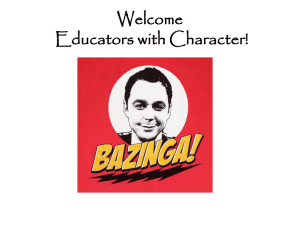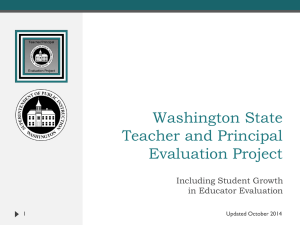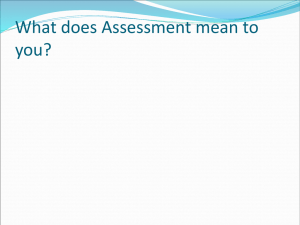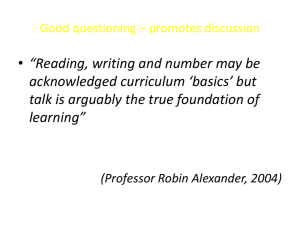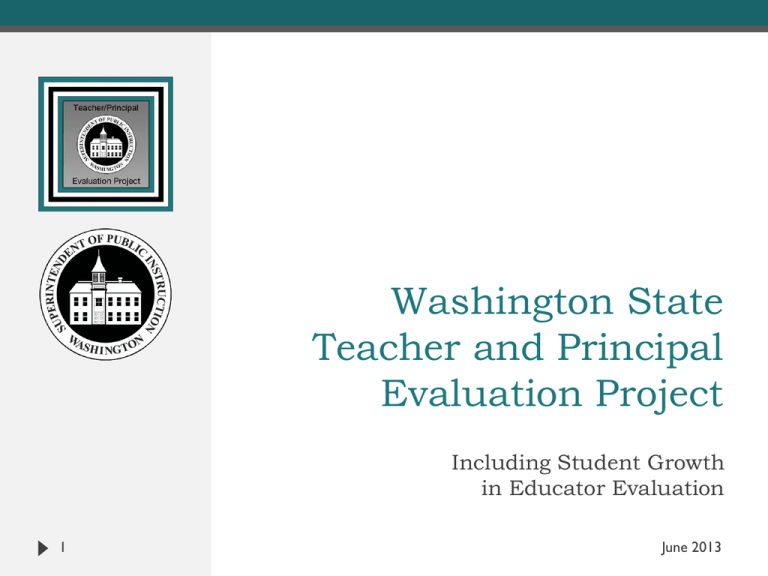
Washington State
Teacher and Principal
Evaluation Project
Including Student Growth
in Educator Evaluation
1
June 2013
Entry Task
As you enter, take several sticky notes and respond to the
following question: How does your district determine whether
students have grown in their learning?
Brainstorm as a team, 1 idea per sticky note, and place as
many sticky notes as you can on the large chart paper
labeled Ways to Determine Student Growth.
2
Welcome!
Introductions
Logistics
Agenda
Agenda
3
Connecting
Learning
Implementing
Reflecting
Wrap-Up
Modules
Introduction to Educator Evaluation in Washington
Using Instructional and Leadership Frameworks in
Educator Evaluation
Preparing and Applying Formative Multiple Measures of
Performance: An Introduction to Self-Assessment, Goal
Setting, and Criterion Scoring
Including Student Growth in Educator Evaluation
Conducting High-Quality Observations and Maximizing
Rater Agreement
Providing High-Quality Feedback for Continuous
Professional Growth and Development
Combining Multiple Measures Into a Summative Rating
4
Session Norms
Pausing
Paraphrasing
Posing Questions
Putting Ideas on the Table
Providing Data
Paying Attention to Self and Others
Presuming Positive Intentions
What Else?
5
Module Overview
This module provides
6
an overview of goal setting for student growth
an orientation to what it means to select classroom-based,
school-based, district-based, and state-based tools and use
student learning data in educator evaluation
a process for establishing student growth goals, examples of
student growth goals, and a process for determining the change
in student achievement between two points in time.
a review of the Washington State student growth rubrics
an orientation to templates and tools you can use to establish
student growth as a measure in educator evaluation.
Connecting
Builds community, prepares the team for learning, and links to
prior knowledge, other modules, and current work
7
Intended Participant Outcomes for
This Module
Participants will know and be able to:
Understand the legislative requirements for using student growth data as
one of several measures in an educator’s evaluation in Washington
Understand student growth in a focused versus comprehensive evaluation
Learn and apply the student growth rubric structure and language
Understand the creation of student growth goals in alignment with the
evaluation criteria
Understand the basic vocabulary and principles of assessment literacy [only if
inserting optional section on assessment literacy]
Identify relevant measures of student growth in your district context
Understand how the four-step process for measuring student growth
applies in your district context
Determine the best approach, tools, and timeline for your district
8
Connecting to Previous Modules:
Multiple Measures
Self Assessment
Perception
Data
Student Work
Observation
9
Student Growth
Evidence Beyond
Observations
Connector: The Visible Learning Story
Number the paragraphs 1-7
While you read:
10
What strikes a chord with
you about teacher
evaluation in general
(underline)?
What matches where your
district currently stands
with its teacher evaluation
process (star)?
What questions does this
raise (question mark)?
Turn and Talk
Turn and talk with a partner
at your table group to
discuss the reading with
regard to teacher evaluation
and its implications for your
district.
Connecting Debrief
Share from your partner conversations:
11
What struck a chord or resonated with you from this reading?
What questions were generated?
Learning I: In the Washington Context:
Legislative Requirements, Focused &
Comprehensive Evaluation
Understand the legislative requirements for using student
growth data as one of several measures in an educator’s
evaluation in Washington
Understand student growth in a focused versus
comprehensive evaluation
12
In Washington…
RCW 28A.405.100
RCW
28A.405.100
RCW 28A.405.100
WAC
RCW 28A.405.100
RCW 28A.405.100
13
8 Criteria Teachers
8 Criteria Principals
Educator
Evaluation
A capital “G!” indicates that
the guidance represents
Washington state law
(RCW) or rules (WAC).
Instructional
and
Leadership
Frameworks
RCW 28A.405.100
Student
Growth
Rubrics
A lower-case “g” indicates that the guidance
represents research-based best practice but
is not mandated by law or rules.
RCW 28A.405.100
ESSB 5895 Establishes New Definitions
Around Student Growth Measures
RCW 28A.405.100
Changes…
Both E2SSB 6696 and ESSB
5895 contain language around Student growth data must be a
substantial factor in evaluating
student growth, including:
the summative performance of
Student growth data that is
certificated classroom teachers
relevant to the teacher and
for at least three of the
subject matter must be a factor
evaluation criteria.
in the evaluation process and
must be based on multiple
Student growth data elements
measures that can include
may include the teacher’s
classroom-based, school-based,
performance as a member of a
district-based, and state-based
grade-level, subject matter, or
tools. Student growth means
other instructional team within
a school when the use of this
the change in student
data is relevant and
achievement between two
appropriate.
points in time.
14
A Culture Shift: Evaluation Measures
Current vs. New
Current Evaluation System
New Evaluation System
Observation: YES
Observation: YES
Student Growth: NO
Student Growth: YES
Other Evidence: NO
Other Evidence:YES
15
RCW 28A.405.100
Defining Key Terms
Student Achievement: The status of subject-matter
knowledge, understandings, and skills at one point in time.
Student Growth (Learning): The growth in subjectmatter knowledge, understandings, and skill over time.
It is student growth, not student achievement,
that is relevant in demonstrating impacts
teachers and principals have on students.
16
Student Growth Data Means…
Formal Tests in
Core Subjects Only
Knowledge and
Learning That Can Be
Measured
All Classroom
Learning
17
Models of Improving Instructional
Practice
18
Student Growth Theory of Action
If state leaders
allocate student
growth funds and
provide a viable
structure for
setting,
monitoring, and
evaluating
student learning
goals…
19
Then district
leaders will
present a vision
for student
learning that
starts with the
students, data,
and standards…
Then teachers
and principals will
set meaningful
learning targets
and monitor
growth for all
students…
(3.1, 6.1,8.1)
And specific
outcomes for
students will
result in all
students reaching
their full learning
potential.
(3.2, 6.2)
Student Growth Is Embedded
in the Criteria
20
RCW 28A.405.100
21
22
Learning II: Unpacking Student
Growth Rubrics for Teachers
Learn and apply the student growth rubric structure and language
23
Student Growth Rubrics
The TPEP steering committee organizations approved
statewide rubrics for student growth to ensure
consistency in implementation of the evaluation system
across Washington State.
RCW 28A.405.100
The rubrics for student growth describe both goal setting and
outputs of student learning.
OSPI has provided student growth rubrics for each of the
three criterion
24
Teachers: 3, 6, and 8
Principals: 3, 5, and 8
Using District, School, and
Classroom-Based Data (Teachers)
RCW 28A.405.100
Five Student Growth Criteria
3.1 Establish Student Growth Goals
Re: individual or subgroups of students (achievement/opportunity gap)
3.2 Achievement of Student Growth Goals
Re: individual or subgroups of students (achievement/opportunity gap)
6.1Establish Student Growth Goals using Multiple Student
Data Elements
Re: whole class based on grade-level standards and aligned to school and
district goals
6.2 Achievement of Student Growth Goals
Re: whole class based on grade-level standards and aligned to school and
district goals
8.1 Establish Team Student Growth Goals
Re: Teacher as part of a grade-level, content area, or other school/district team
25
The Student Growth Rubric
26
RCW 28A.405.100
Learning Activity II: Unpacking the
Student Growth Rubric
Individually:
Read across the rows and highlight
the key descriptions of
performance at each level.
Look down the column and circle
the key words or ideas that best
summarize each of the four
performance levels.
As a table group/district team
answer these questions and create
3 charts:
27
What are the key differences
between proficient and distinguished?
Between proficient and basic?
Between basic and unsatisfactory?
What does a teacher need
to know, say, and do to
demonstrate proficiency on
these rubrics? Create a chart
for each criterion.
Criterion ___
Learning Activity II: Debrief
Each team names for the large group a key characteristic
of the student growth rubric – either in terms of a
performance level description or in terms of the key
actions needed by teachers.
Each team names 1 thing that teachers need to know, say,
or do to demonstrate proficiency on the student growth
rubric.
28
Learning III: Creating Student
Growth Goals
Understand the creation of student growth goals in alignment
with the evaluation criteria
29
Using the Rubrics
In a practical sense, we want
growth goals to not be too
large, not be too small, but
just right (think Goldilocks
and the three bears). Not
too broad, not too narrow,
but just right.
Another way to think of the
three student growth criteria
is analogous to ‘nesting dolls,’
moving from large to small (8
to 6 to 3) or small to large (3
to 6 to 8)
30
Example of “Nested” Goals
3.1 Establish Student Growth Goals (individual
or subgroups of students)
Between September and May, all ELL Students will
improve their ability to provide text-based evidence
to support prediction, inference, and opinion. They
will use supports such as differentiated text, a scaffold
frame, or an oral reader and uses texts appropriate to
their reading level. At least 80% of the students will
improve at least one level in two of the three skills, as
measured by a four-point rubric.
6.1 Establish Student Growth Goals Using
Multiple Student Data Elements (whole class
based on grade-level standards and aligned to
school and district goals)
Between September and May, students will improve
their ability to provide text-based evidence to
support prediction, inference, and opinion. At least
90% of the students will improve at least one level in
each of the three skills, as measured by a four-point
rubric.
31
8.1 Establish Team Student Growth Goals
(teacher as part of a grade-level, content area, or
other school/district team)
Between September and May, all 8thgrade students will
improve their ability to provide text-based evidence
to support prediction, inference, and opinion as
measured bye a four-point rubric. At least 70% of the
students will improve at least one level in each of the
three skills, as measured bye a four-point rubric. The
8th grade team will meet every six weeks through the
year to examine student work and calibrate
expectations.
Goldilocks Approach: Example Goals
STUDENT GROWTH GOAL
Literacy: Informational Text Writing K-5
6.1
Whole Group
32
Too Narrow
JUST RIGHT
All students (with
100% accuracy)
will determine the
meaning of the
root word when
the affix ‘un’ is
added.
In the 2013-2014 year students in my
science class will accurately identify, define,
and use vocabulary appropriate to the
rocks and minerals content area. Tier II
word use will transfer to other subject
areas, e.g., observation, properties. This will
be measured through a pre-test, formative
assessment, think~write~pair~share,
reflective writing, and a post-test.
Too Broad
All of my students
will understand and
apply grade level
vocabulary to
content areas.
Learning Activity III: Creating Growth
Goals
In your table groups, you will spend 25-30 minutes
creating examples of student growth goals using the
“goldilocks approach” – a goal that is too broad, a goal
that is too narrow, and a goal that is just right.
You can choose the goal’s focus. Some suggestions are:
33
Art – elementary level
Literacy – kindergarten
Science – middle school level
Foreign language – high school level
Social science – high school level
Debrief Learning Activity III
Gallery Walk: Review the goals from each group
Provide sticker dot feedback under each section
Debrief
34
Agree that
this goal
fits in this
category
Disagree
that this
goal fits in
this
category
Was this brief experience harder or easier than you expected?
How might you apply this activity to working with groups of
educators in your district?
What do you think you need to do immediately to start this
process?
Learning IV: Assessment Literacy –
What Makes a Good Assessment
Understand the basic vocabulary and principles of
assessment literacy
35
Measures That Help Educators Grow
Select and implement measures that:
36
Support educators to examine their own practice against
specific criteria
Allow educators to co-construct the evaluation
Give educators opportunities to discuss the results
Are directly aligned with teaching or leadership standards
Include protocols and processes that are transparent and
understandable
Assessment Literacy Basics
What is good assessment?
37
Alignment
Stretch
Reliability
Validity
Appropriate Assessments
Does the assessment
38
Align with content standards and course content?
Have stretch?
Have sufficient validity and reliability?
Alignment Considerations
Assessments should cover key subject and grade-level
content standards.
No items, questions, or prompts should cover standards
that the course does not address.
The assessment structure should mirror the distribution
of teaching time devoted to course content.
The cognitive demands of the assessment should match
the full range of cognitive thinking required during the
course.
39
Stretch
Assessments should
Allow both low- and high-performing students to demonstrate
growth.
Challenge the highest-performing students.
Student A
Lowest-performing
students
40
Student B
Student C
Student E
Student D
Student F
Highest-performing
students
Validity and Reliability Considerations
The assessment should
Be valid—it measures what it says it measures.
41
Consistent with other evidence.
Relevant for its purpose.
Be reliable—it produces consistent results.
Contain clearly written and concise questions and directions.
Be fair to all groups of students.
Use consistent administration procedures.
Reliability and Validity
X Valid
X Reliable
42
X Valid
Reliable
Valid
Reliable
Learning Activity IV: Data Wise Jigsaw
Each person will read a
section from Chapter 2 in
Data Wise
Each person needs to have
one “most” significant idea
from the text underlined
or highlighted in the
reading. It is often helpful
to identify a “back-up”
selection as well.
Final Word Discussion
43
Go around the circle in
order of the pages in the
chapter.
Read what was most
significant and explain (3 min)
Respond to the text and
explanation from others in
the group (1 min each)
Final word from the
person who began (1 min)
Repeat this process
Learning Activity IV: Debrief
What are the general basics of assessment that everyone
must know?
How are these basics important to the process of
including student growth as a measure in educator
evaluation?
What are some strategies for ensuring that all
professional staff in the district (or school) know these
basics?
44
Learning V: Student
Learning Measures
Identify relevant measures of student growth in your
district context
45
District-Determined Measures
RCW 28A.405.100
Districts have a lot of control over the classroom-,
school-, and/or district-based tools used to measure and
report student growth data.
A student growth goal describes what students will
know/be able to do at the end of an instructional period
based on course- or grade-level content standards and
district curriculum.
Student growth data means relevant multiple measures
using classroom-based, school-based, district-based, and
state-based tools.
46
Available Student Growth Measures
TPEP Pilot Site Data
Multiple Measurement Tools
This chart represents data collected from TPEP districts and a sample of the strengths and limitations of implementing measures.
Measure
ClassroomBased Tools
SchoolBased Tools
DistrictBased Tools
State-Based
Tools
47
Examples
% of teachers=
assessment*
100%
79%
30.8%
16.2%
Strengths
Student work
Graphic organizers
Performance tasks
Unit assessments
Art/PE performance
assessments
Common formative
assessments
7th grade writing
samples
Kindergarten readiness
District-developed
benchmark exams
MAP assessments
DIBELS (literacy)
MSP
HSPE
SAT
ACT
AP exams
Limitations
Capture authentic
student work and
learning
Relevant to teachers
to inform practice in
a timely way
Encourage team goal
setting
Relevant to both
teacher/principal
evaluations
Can compare across
schools/districts
Useful in district-wide
PLC and vertical
teaming
Higher likelihood of
validity for assessing
student performance
Widely available and
public
Difficult to compare across
classrooms
May lack validity
More time involved to
assess students
May not be comparable
between districts
Training for principals key
to implementation
May not have district
capacity to support timely
use of data
May lack reliability in
administration of
assessments
Only relevant to a small
percentage of teachers
Data is not quickly
accessible to quickly
inform teaching practice
The Data Pyramid: What Kind of Data
Do Teachers Use? How Often?
Annually
2-4 times
a year
Quarterly or
end of the unit
1-4 times
a month
Daily
Summative
assessments
Data about people,
practices, perceptions
Benchmark/interim common
assessments
Formative common assessments
Formative classroom assessments
Adapted from N. Love, K. E. Stiles, S. Mundry, and K. DiRanna, The Data Coach’s Guide to Improving Learning for All
Students: Unleashing the Power of Collaborative Inquiry, Thousand Oaks, CA: Corwin, 2008. All rights reserved.
48
Inverted Triangle—Not Recommended
49
A Data Pyramid for Washington
Educators
Annually
2-4 times
a year
Quarterly or
end of unit
1-4 times
a month
Daily/
weekly
50
End of course exam (EOC),
MSP, ACT, SAT, ASVAB,
PSAT, IB tests, AP tests,
WELPA (ELL), district finals
Benchmark assessments, MAP
(Measure of Academic Process),
DIBELS, music performances,)
finals/mid-terms, common
assessments, RBA (ELA), fit-n-fun day
Unit test, project/exam = summative demonstration,
practice MSP portfolio, grade-level common
assessments, oral exams, skills performance test,
collaborative with classroom teachers - 6 trait writing:
transferable learning, PB exams, RCBM,
Performance tasks
Unit test/project, common formative assessment, essays
(all content areas), literature circles, writing groups presentation and
projects with rubric criteria, peer assessments, quizzes, writing samples,
student self assessment, timed writing probes, weekly math-fact fluency,
writers workshop writing samples, AIMS (reading/math assessment),
running records
Entry/exit slips, quiz, homework, quick checks, focus task, summary task, think-pair-share,
student reflection, note check, student dialogue/discourse/demonstration, student white
boards, conferring with students, diagram labeled with words (ELL), student interviews,
hand votes, written responses, science lab, math practice
Learning Activity IV: Creating Your Own
Data Pyramid for Your District
Annually
2-4 times
a year
Quarterly or
end of unit
1-4 times
a month
Daily/
weekly
51
Learning V Debrief
Let’s put the pieces
together from the learning
segments of the sessions
so far:
Student growth rubrics
Student growth goal setting
A pyramid of student
assessments
How do you see these
pieces fitting together?
How do these pieces
relate to the student
growth theory of action?
52
Student Growth Theory of Action
If state leaders
allocate
student
growth funds
and provide a
viable
structure for
setting,
monitoring,
and evaluating
student
learning
goals…
Then district
leaders will
present a
vision for
student
learning that
starts with
the students,
data, and
standards…
Then
teachers and
principals
will set
meaningful
learning
targets and
monitor
growth for
all
students…
(3.1, 6.1,8.1)
And specific
outcomes
for students
will result in
all students
reaching
their full
learning
potential.
(3.2, 6.2)
Learning VI: Washington Process
for Determining Student Growth
Understand how the four-step process for measuring student
growth applies in your district context
53
Student Growth Process
1.
2.
3.
4.
54
Establishing a focus for the student growth (SG) goal
Documenting assessments and scoring
Establishing targets
Evaluating goals
Step 1: Establishing the Focus for
Student Growth
Establishing a focus for the student
growth goal(s) is a critical first step.
This can be done in an instructional
team, in a conference between
teacher and principal, or individually.
What is a student growth goal?
A description of what students will know/be able to
do at the end of an instructional period based on
course- or grade-level content standards and curriculum.
55
55
Documenting Assessments and Scoring
Assessments should be standards-based, of high quality,
and designed to best measure the knowledge and skills
found in the learning goal. The assessment should be
accompanied by clear criteria or rubrics to describe what
students have learned.
56
Assessments and Scoring
We need high-quality assessments to evaluate the extent to
which students have achieved the goals
Some thoughts before delving into “assessments”:
57
Think broadly about “assessment” (e.g., performance assessments,
project-based)
Do not let the assessment drive the goal; the assessment
should be used to support learning goals (let’s move to “enduring
understandings”)
The learning goal and assessment should be things that teachers
would use in the classroom as part of good instructional practice
Campbell’s Law! The goal is not higher test scores!
Determine how students can be incorporated in the goal-setting
process in order to have them take some ownership of their own
learning.
Establishing Targets
Identify the expected outcomes by the end of the
instructional period for the whole class (criterion 6)
or for subgroups (criterion 3), as appropriate.
Criterion 3:
Subgroup of
students not
meeting full
learning
potential.
High evidence of learning for
all/nearly students
Target would be:
Clear evidence of learning for
most students
(Achievement
Target would be:
Gap)
58
Evaluating Goals for Criterion SG 3.1
Review of the Learning Goal (s)
Use the following protocol to
confirm that the Learning
Goal has the right size, detail,
and depth necessary.
(proficient level language is
used, please see the critical
attributes resource for
additional levels of
performance)
Check the boxes that apply.
59
The Learning Goal:
Identifies subgroups and uses data that identifies students not
reaching full learning potential (i.e. achievement/opportunity gaps,
ELL, special education, highly capable)*
is specific, measureable and time-bound
is based on multiple sources of available data that reveal prior
student learning
is aligned to content standards
is appropriate for the context, instructional interval and content
standard(s) (grain size)
demonstrates a significant impact on student learning of content
(transferable skills)
Identifies formative and summative measures aligned to learning
targets to monitor progress towards goals
Evaluating Criterion SG 3.2
Student growth criterion 3.2: Make a student learning claim and provide evidence
for the actual outcomes at the end of the instructional period for subgroups not
meeting full learning potential.
Teacher completes the section below.
Make a rating claim
as to the level of the
actual outcomes
based on the goals
for student learning.
Claim
High evidence of learning for all/nearly all students (Distinguished)
Clear evidence of learning for most students (Proficient)
Some evidence of learning for some students (Basic)
No evidence of learning for most students (Unsatisfactory)
Please provide student learning evidence from at least two points in time that
supports your claim of student learning (2 or more sources):
60
Implementing I: Using the
Student Growth Template
Determine the best approach, tools, and timeline for your district
61
District Learning Progression for Student
Growth Goal Setting and Outcomes
Basic: Use the
Goldilocks
Approach
62
Proficient: Use
the Modified
or Full Student
Growth
Template
Distinguished:
Use the Full
Student
Growth
Template
Full Student Growth Goal
Setting Template
This type of product is
what teachers and
evaluators produce as a
result of the conversations
about student growth.
Example template based
on the National Center
for Assessment and
Accountability.
Districts can create their
own or modify this one.
63
District Learning Progression
Determine the readiness of your district’s teachers and
principals to create student goals with:
The goldilocks approach
A modified goal setting template
The full goal setting template
Page10 in your handout packet provides some guidance
to your team for this progression. Eventually all teachers
should be able to use the template.
64
Implementing II:
District Planning Tool
Determine the best approach, tools, and timeline for your district
65
District Planning Tool
On pages 15-21 of your handout packet is a district
planning tool you can use for the remaining time in this
session to begin planning your approach to student
growth.
66
Reflecting
67
Debrief
Take a few minutes and create at least three sticky notes
for the Stop/Start/Continue Chart on your way out.
Stop: What didn’t work in this session? What should not be
included in the future?
Start: What didn’t happen that should have in this session?
What should be planned for future sessions?
Continue: What worked well and should be continued in future
sessions like this?
Stop
68
Start
Continue
What’s Next?
Conducting High-Quality Observations and Achieving
Rater Agreement module
Homework Options
69
District: Complete the district planning tools and create a plan
to share with broader district staff.
School or teams: Begin conversations about student growth
and how it is measured. Begin to help staff understand the
assessment or data pyramid and a balanced approach.
Individual: Do additional reading or complete additional
professional development on assessment literacy and balanced
assessment.
Thank you!
Presenter Name
xxxxxxxxxxx@xxx.xxx
70

